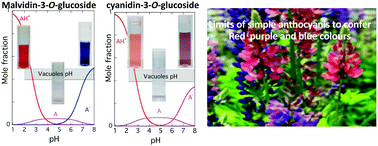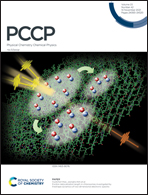Strategies used by nature to fix the red, purple and blue colours in plants: a physical chemistry approach
Abstract
While identified by the respective flavylium cation, anthocyanins are much more than this molecule. The flavylium cation (generally appearing only at very acidic pH values) is one of the molecules of a complex sequence of pH dependent molecular species reversibly interconnected by different chemical reactions. These species include the red flavylium cation, purple quinoidal base and blue or bluish anionic quinoidal bases. At the common pH of the vacuoles of simpler anthocyanins, the red flavylium cation is present only at very acidic pH values and at moderately acidic pHs there is no significant colour of the purple quinoidal base. Moreover, the blue or bluish anionic quinoidal base appearing around neutral pH values is not stable. Intermolecular (copigmentation) and intramolecular (in acylated anthocyanins) interactions increase the colour hue and yield bathochromic shifts in the absorption bands, permitting to extend the pH domain of the flavylium cation and increase the mole fraction of the quinoidal bases. Metal complexation is another strategy. In particular, the Al3+ cation plays an essential role in the blue colour of hydrangea. The most sophisticated structures are however the metaloanthocyanins, such as the one that gives the blue colour of commelina communis, constituted of six anthocyanins, six flavanones and two metals. In this work we discuss how physical chemical tools are indispensable to account for the chemical behaviour of these complex systems. The experimental procedures and the equations needed to calculate all equilibrium constants of anthocyanins and the consequent pH dependent mole fraction distributions in the absence or presence of copigments are described in detail. Reverse pH jumps monitored by stopped flow have been shown to be an indispensable tool to calculate these parameters.

- This article is part of the themed collection: PCCP Perspectives


 Please wait while we load your content...
Please wait while we load your content...